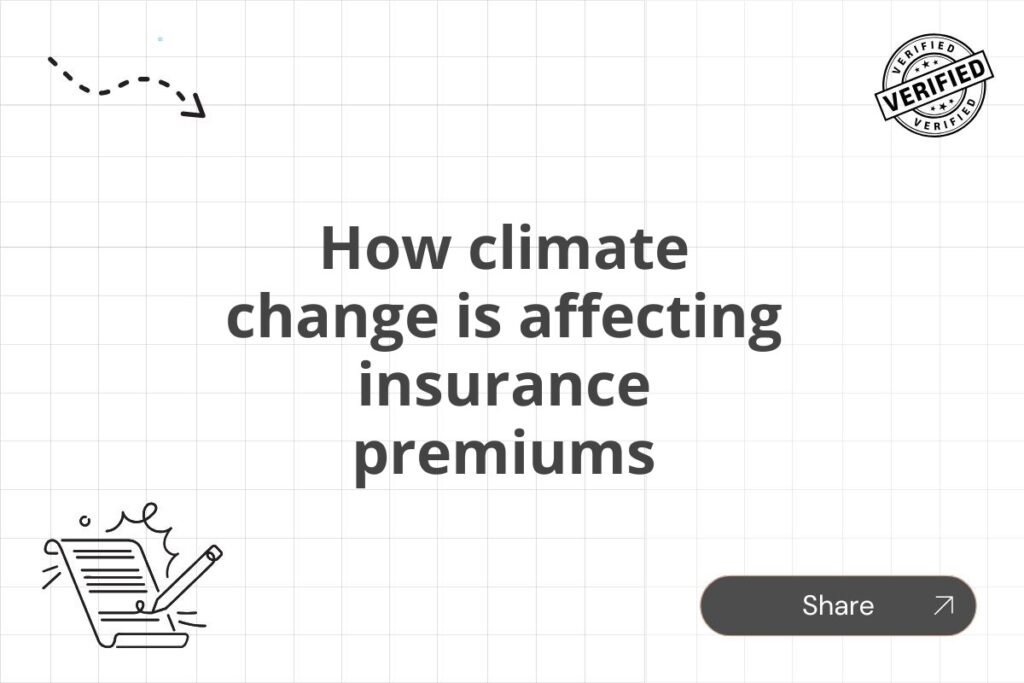Meta Description: Climate change fuels rising insurance premiums. Learn how extreme weather events, sea-level rise, and shifting risk profiles are impacting your insurance costs and what you can do. Get informed now.
The rising cost of insurance premiums is a concern for many, and for good reason. While several factors contribute to these increases, one of the most significant and increasingly impactful is climate change. The connection might not be immediately obvious, but the effects of a warming planet are dramatically reshaping the insurance landscape, leading to higher premiums across various lines of coverage.
This article delves into the multifaceted ways climate change is affecting insurance premiums, exploring the scientific evidence, the resulting financial implications, and what individuals and businesses can do to mitigate the risks and potentially lower their costs.
The Direct Impact of Extreme Weather Events
Perhaps the most immediate and visible impact of climate change on insurance is the escalating frequency and severity of extreme weather events. Warmer temperatures fuel more intense hurricanes, typhoons, wildfires, floods, and droughts. These events cause billions of dollars in damage annually, resulting in substantial payouts for insurance companies. To offset these losses and maintain profitability, insurers are forced to raise premiums to cover the increased risk.
Increased Frequency of Claims
As climate change intensifies extreme weather, the number of insurance claims surges. This increased claim frequency directly translates into higher payouts for insurance companies. For example, the increasing number of devastating hurricanes impacting coastal regions leads to a significant rise in property damage claims, forcing insurers to increase homeowners’ and commercial property insurance premiums in vulnerable areas.
Higher Severity of Losses
Climate change isn’t just increasing the
frequency
of extreme weather events; it’s also increasing their
severity
. Hurricanes are becoming stronger, wildfires are burning larger areas, and floods are reaching unprecedented levels. This translates to significantly higher payouts per claim, further driving up insurance costs. The damage caused by a single, unusually intense event can dwarf the losses from multiple smaller events in the past.
Geographic Expansion of Risk
Previously low-risk areas are now experiencing increased exposure to extreme weather events. As climate patterns shift, regions historically untouched by hurricanes or wildfires are now facing these risks, requiring insurers to expand coverage and recalculate risk assessments, often leading to higher premiums in previously low-cost areas.
The Indirect Impact of Climate Change on Insurance
Beyond the direct costs associated with extreme weather events, climate change exerts indirect pressures on insurance premiums. These indirect impacts are often less obvious but equally significant in the long run.
Sea-Level Rise and Coastal Erosion
Rising sea levels and increased coastal erosion pose a long-term threat to coastal properties. The risk of flooding and damage from storm surges is dramatically increasing, making insurance for coastal properties increasingly expensive. Insurers are actively reassessing the risk profiles of coastal properties, leading to higher premiums or even the refusal to insure properties in highly vulnerable locations.
Increased Wildfire Risk and Shifting Forest Ecosystems
Climate change contributes to drier conditions and increased wildfire risks. This not only leads to direct property damage but also affects the availability and cost of insurance. Insurers are carefully evaluating the proximity of properties to forests and other flammable vegetation, influencing premium calculations and potentially impacting insurability.
Infrastructure Damage and Disruption
Extreme weather events cause significant damage to infrastructure, including roads, bridges, power grids, and water systems. This damage disrupts business operations, leading to business interruption claims and increasing the cost of business insurance. The long-term cost of rebuilding and maintaining resilient infrastructure also contributes to higher insurance premiums.
The Role of Insurance Companies in Addressing Climate Change
Insurance companies are not merely passive observers of climate change; they are actively involved in addressing the risks it poses. Many insurers are incorporating climate change data into their risk assessments, developing more sophisticated models to predict future losses, and implementing proactive measures to mitigate risks.
Developing Climate Risk Models
Sophisticated climate models are being used to assess the future risks associated with climate change. These models help insurers to understand the probability and severity of future losses, enabling them to set premiums more accurately and effectively manage their exposure to climate-related risks.
Investing in Climate Resilience
Some insurers are investing in initiatives to build climate resilience in communities and businesses. This might involve supporting infrastructure improvements, promoting climate adaptation strategies, and developing innovative insurance products that encourage risk reduction.
Implementing Climate-Based Underwriting
Insurers are incorporating climate risk factors into their underwriting processes, leading to more differentiated pricing based on location, property type, and susceptibility to climate-related events.
What Individuals and Businesses Can Do
While climate change presents significant challenges, individuals and businesses can take proactive steps to mitigate the impact on their insurance premiums.
In conclusion, the impact of climate change on insurance premiums is undeniable. The increasing frequency and severity of extreme weather events, coupled with the long-term effects of sea-level rise and changing climate patterns, are driving up insurance costs. However, by understanding the connection between climate change and insurance, and by taking proactive steps to mitigate risks, individuals and businesses can better navigate this evolving landscape and manage the cost of their insurance.






















